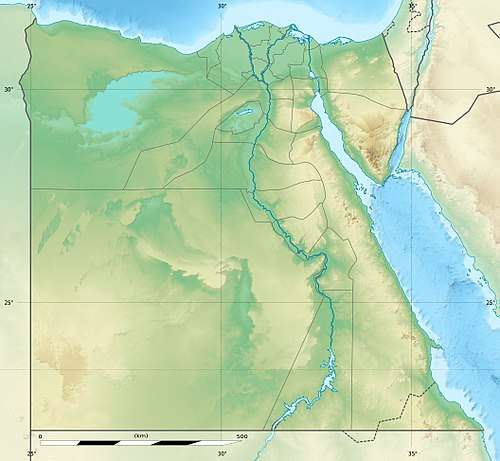Hu, Egypt
Hu (Arabic: هُ) is the modern name of an Egyptian town on the Nile, which in more ancient times was the capital of the 7th Nome of Upper Egypt.
Hiw هُ Hu | |
|---|---|
 Hiw Location in Egypt | |
| Coordinates: 26°1′N 32°17′E | |
| Country | |
| Governorate | Qena |
| Time zone | UTC+2 (EST) |
| ḥt sšmw[1][2] in hieroglyphs |
|---|
The nome was referred to as Sesheshet (Sistrum). The main city was referred to as Hu(t)-sekhem, which became abbreviated as Hu. This led to the Arabic name Hiw.
In Ptolemaic times the city was called Diospolis Parva (Little Zeus-City) in comparison with Thebes, Egypt, known as Diospolis Magna (Great Zeus-City). It also was called Diospolis Superior (Upper Zeus-City), in comparison with Diospolis Inferior (Lower Zeus-City) in the Nile Delta.
%2C_Egypt._The_Petrie_Museum_of_Egyptian_Archaeology%2C_London.jpg)
Ancient history
Hu was the centre of the cult surrounding Bat, a goddess in Egyptian mythology.[3] The sistrum, a sacred instrument associated with her, often shaped to resemble her, and for which the 7th nome was named, remained sacred throughout the history of Ancient Egypt and is seen in its art and hieroglyphs.
The goddess Bat remained the main deity worshiped there until at least the time of the twelfth dynasty as she is mentioned on a shrine belonging to Senusret I. By the time of the New Kingdom during the eighteenth dynasty, the characteristics of Bat were subsumed into those of a similar goddess, Hathor, who then became the main deity worshiped at Hu.[4] Previously they may have been the same deity.
Modern history
In 1326, Ibn Battuta passed through Hu, where he visited a sharif named Abu Muhammad Abdallah al-Hasani. When he learned of Ibn Battuta's intention to go on the hajj to Mecca by way of Aydhab, the sharif predicted that he would not succeed and would only reach Mecca by way of the road through Syria; he told Ibn Battuta to return to Cairo instead. Ibn Battuta went on to Aydhab anyway, but upon arriving, he found that local Beja tribespeople, in revolt against the Mamluk governor, had driven out the town's garrison and sunk ships in the harbor, preventing anyone from setting sail to Hejaz. Ibn Battuta was left with no choice but to return to Cairo.[5]
The 1885 Census of Egypt recorded Hu as a nahiyah under the district of Dishna in Qena Governorate; at that time, the population of the town was 3,958 (2,011 men and 1,947 women).[6]
References
- Wallis Budge, E. A. (1920). An Egyptian hieroglyphic dictionary: with an index of English words, king list and geological list with indexes, list of hieroglyphic characters, coptic and semitic alphabets, etc. Vol II. John Murray. p. 1018.
- Gauthier, Henri (1927). Dictionnaire des Noms Géographiques Contenus dans les Textes Hiéroglyphiques Vol. 4. pp. 129–130.
- Robert Morkot, The Egyptians: an introduction, Psychology Press, 2005. Retrieved from google books
- The Horizon: Studies in Egyptology in Honour of M.A. Nur El-Din edited by Basem El-Sharkaway, retrieved from google books
- Dunn, Ross E. (1986). The Adventures of Ibn Battuta: A Muslim Traveler of the Fourteenth Century. University of California Press. pp. 53–54. ISBN 0520931718. Retrieved 21 June 2020.
- Egypt min. of finance, census dept (1885). Recensement général de l'Égypte. p. 147. Retrieved 21 June 2020.